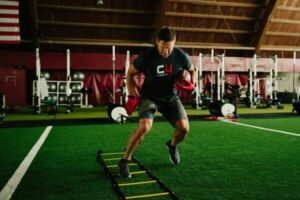Walking into a running shoe store can be daunting, but knowing the common terminology and the concepts behind them is the first step to feeling empowered. These commonly discussed running shoe terms will get you off on the right foot and will be a good starting point for you to begin more in-depth research on finding the perfect running shoe for you.
Know Your Lingo
“Drop” This term refers to the difference in millimeters between the heel and the forefoot. The industry standard is 12 millimeters. However, with the “minimal” and “barefoot” trend pervading the industry, many shoe companies have included lower heel-to-toe-ratio models in their lines. “Ride” The ride refers to what it feels like to run in a shoe. A “plush ride” means the shoe is designed to feel super soft while running. A responsive ride means the shoe is designed to feel like it responds to the ground, giving energy back, instead of feeling dead under your foot. “Minimal”  Minimal is a trend that simply refers to less. Some companies address this by providing a more traditional amount of foam under your foot, with a low heel to toe (like the Saucony Cortana). Other companies go with less foam and low drop (such as many Altra models or the Brooks Pure Project). Regardless of approach, the minimal trend means different companies are approaching the “more with less” from different angles. “Medial” vs. “Lateral” These two terms are taken from the world of anatomy and refer to what side of the body something is on. The Medial side is the inside of the body, and the Lateral side is the outside of the body. These terms are applied to running shoes to provide reference where technology is inserted or how the shoe is constructed. “Stability” vs. “Neutral” Stability models are designed to help prevent over-pronation, which occurs when the foot rolls inward during the transition from heel to toe. Pronation itself is a normal occurrence, but over-pronation happens when the foot pronates too much and too quickly, placing extra stress on the lower leg and foot muscles. Most shoe companies have at least one model that addresses this by placing denser (think less soft) foam along the medial side of the shoe, called a post. The more stable the shoe is designed to be, the longer the post. The idea is that the harder surface of the denser foam will slow the acceleration of the inward rolling. Typically, the higher the price point the more stability is involved. But that doesn’t mean the highest priced shoe is the best shoe. Each runner has different needs. One runner might only need a light stability shoe with only a little post, while another may need a large post. Neutral shoes, on the other hand, will not have this dense foam on the medial side. Their focus will instead be on providing cushioning and comfort. Generally, the higher the price point means more cushioning and a more “plush” feel. Sometimes, companies will incorporate two different types of foam in an effort to provide a softer landing, or create a softer ride. The term “neutral” refers to the lack of a post or stability feature. “Performance” and “Lightweight”
Minimal is a trend that simply refers to less. Some companies address this by providing a more traditional amount of foam under your foot, with a low heel to toe (like the Saucony Cortana). Other companies go with less foam and low drop (such as many Altra models or the Brooks Pure Project). Regardless of approach, the minimal trend means different companies are approaching the “more with less” from different angles. “Medial” vs. “Lateral” These two terms are taken from the world of anatomy and refer to what side of the body something is on. The Medial side is the inside of the body, and the Lateral side is the outside of the body. These terms are applied to running shoes to provide reference where technology is inserted or how the shoe is constructed. “Stability” vs. “Neutral” Stability models are designed to help prevent over-pronation, which occurs when the foot rolls inward during the transition from heel to toe. Pronation itself is a normal occurrence, but over-pronation happens when the foot pronates too much and too quickly, placing extra stress on the lower leg and foot muscles. Most shoe companies have at least one model that addresses this by placing denser (think less soft) foam along the medial side of the shoe, called a post. The more stable the shoe is designed to be, the longer the post. The idea is that the harder surface of the denser foam will slow the acceleration of the inward rolling. Typically, the higher the price point the more stability is involved. But that doesn’t mean the highest priced shoe is the best shoe. Each runner has different needs. One runner might only need a light stability shoe with only a little post, while another may need a large post. Neutral shoes, on the other hand, will not have this dense foam on the medial side. Their focus will instead be on providing cushioning and comfort. Generally, the higher the price point means more cushioning and a more “plush” feel. Sometimes, companies will incorporate two different types of foam in an effort to provide a softer landing, or create a softer ride. The term “neutral” refers to the lack of a post or stability feature. “Performance” and “Lightweight”  Many companies are offering models described as “lightweight performance” or “lightweight trainers”. These shoes are designed to give runners another option for training. Performance oriented runners will be doing at least one (if not more) hard workouts per week, including tempo runs, hill repeats, fartleks, or progression runs (just to name a few). Lightweight trainers are meant to be an option for these faster runs. They are usually lighter and sleeker than their “daily trainer” counterparts, and typically have a lower drop. This makes it easier for runners to get up on their toes to go faster, and prevents the heavy or “klutzy” feeling that can sometimes accompany trying to run faster in a more robust training shoe. These shoes also work well as racing shoes for longer distances like the half marathon and marathon.
Many companies are offering models described as “lightweight performance” or “lightweight trainers”. These shoes are designed to give runners another option for training. Performance oriented runners will be doing at least one (if not more) hard workouts per week, including tempo runs, hill repeats, fartleks, or progression runs (just to name a few). Lightweight trainers are meant to be an option for these faster runs. They are usually lighter and sleeker than their “daily trainer” counterparts, and typically have a lower drop. This makes it easier for runners to get up on their toes to go faster, and prevents the heavy or “klutzy” feeling that can sometimes accompany trying to run faster in a more robust training shoe. These shoes also work well as racing shoes for longer distances like the half marathon and marathon.
Know Your Limits
Running shoe foam doesn’t keep its elasticity forever. After a while it gets compressed, and those places where your foot might hit the outer edge a little hard, or toe off a little on the inside, will only continue to be more ingrained in the foam the more miles it goes through. It’s best to switch out your shoes after 300 miles or so. High mileage runners may want to consider having multiple pairs of shoes that they rotate through. And many runners like mixing up weight and drops, using a more traditional neutral or stability model for slower, recovery days when the body is tired, and a lower drop, lightweight model on their hard days when they’re ready to run fast.
Know Yourself
There are a lot of different opinions when it comes to running shoes, but nothing beats your own experience. Just because the minimal trend is alive and well doesn’t mean it’s the best option for your situation. Like all things, each individual will react and respond to stimulus differently. Your training regimen, mileage level, intensity level, along with your own anatomy, strength, and foot structure will all play a part in determining what shoe will work best for you. Go for quality and don’t pay attention to fads. Find a shoe that works for you and stick with it. 
How useful was this post?
Click on a star to rate it!
Average rating 0 / 5. Vote count: 0
No votes so far! Be the first to rate this post.



